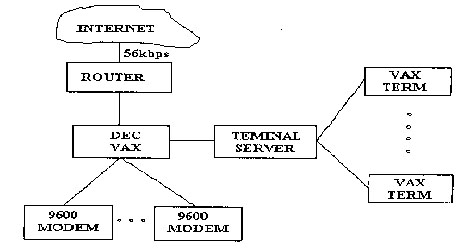
LEARNING IN THE CLASSROOM
Based on two NSF grants, this university has connected to the Internet, upgraded computers, developed a campus backbone network and connected all of the main buildings on campus to it. At the same time, technology has been introduced as experiential exercises in a number of classes:
This paper will review the transition of a university as it moved from simple 286 PC computer labs to networked, integrated technological tools for the classroom to enhance the experiential experiences of the students.
In the early 1990's, the University of Tampa provided students with two laboratories that contained 20-286 PCs each, connected via Novell networks. These labs were used to provide hands-on training for word processing, spreadsheets, and DOS/Windows operations. Shortly after that, the University received two NSF grants l that provided the seed money to rapidly upgrade the labs with state of the art equipment, software and Internet access. This capability provided more opportunities for experiential teaching and learning.
Internet Access and Improvements
In the spring of 1994, the university contracted with a local Internet service provider for Internet access over a 56kbps link. Internet access was limited to a DEC VAX system and associated VAX terminals. 9600 baud modems provided off campus access into the VAX and Internet. Beginning in the fall of 1994, the Internet was used in the Introduction to Computers courses so students could use e-mail, telnet, gophers, ftp and chat. This opened up a new world to our students, enabling them to communicate around the world.

Figure 1. Initial 56kbps Internet Network.
By the spring of 1995, the university introduced Netscape Navigator into the network. All of a sudden, students were able to use a graphical interface to surf the net and usage started to sky rocket. Soon, the capacity of the 56kbps link began to cause long response times. In the fall of 1995, a firewall was installed, the university developed an Intranet on a campus backbone network and a simple web page was initiated for the university.
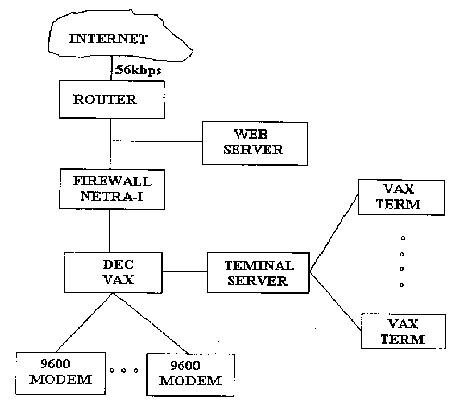
Figure 2. Installation of Firewall and Web Server.
During the summer of 1996, the Internet access link was increased to a Tl (1.544Mbps). Response time rebounded and students were delighted with the information readily available at the computer. Additionally, the student laboratories, several classrooms, and some administrative and faculty offices were connected to the backbone. This dramatically increased the accessibility of the Internet and Intranet.
During this same time period, the university began to migrate away from Novell networks to Microsoft Windows NT networks. This was done to standardize on a system that was easier to install and maintain. Also, PCs where upgraded to Windows 95 and/or Windows NT clients.
Students began using the Internet for a variety of reasons. One student performed an independent study of business ethics attitudes in Central and South America. She contacted a number of university students in these regions and developed a dialog with them to discuss this topic. The intended outcome of this study is a publishable paper that will contrast the ethical attitudes between these regions and the United States.
Another anticipated use of the Internet will occur this fall when MBA classes from The University of Tampa and Monterrey Institute of Technology in Monterrey, Mexico, will negotiate a business case. The case will be presented to both classes and all negotiations will be done over the Internet using e-mail and interactive video. It is anticipated that the final debriefing of the case will be done with the two classes over a 2-way satellite link between the universities
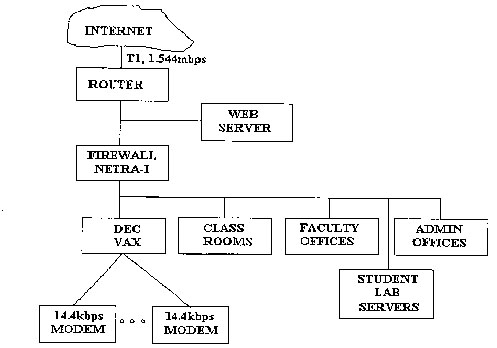
Figure 3. Final Network Configuration with T1 Internet Access.
Sun Microsystems Laboratory and Software Through Pictures Case Tool
The first NSF grant provided seed money to buy a SUN SPARC20 server, 10 SPARC5 client machines, and a SUN laser printer, all networked through a 12 port, 10BaseT hub. These computers use a UNIX type operating system (SOLARIS 2) and considerable time was spent getting the computers and CASE tool (Software through Pictures 3, StP) operational. However, once operational, upper class CIS majors used the systems to model a business system from the early planning stage through the implementation stage in a Systems Analysis and Design course (2 semester course, analysis the first semester and design the second).
The Systems Analysis and Design course was run as a formal business project simulation to expose the students to real life problems. Students were divided into teams and they worked collaboratively on a real business project, tests and presentations. In addition to the CASE tool, a project planning and monitoring tool, Microsoft's Project, was used to provide experience in developing PERT/GANTT charts for defining and monitoring the project.
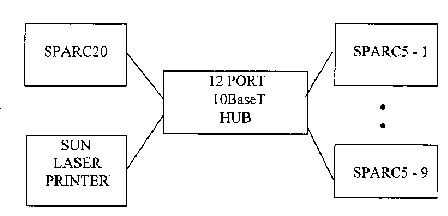
Figure 4. SUN Network Configuration.
| 1. Data Flow Diagram Construction | Development of data movement and storage
model of a system
Automatic rule checking Parent/child navigation |
| 2. Entity Relationship Construction | Development of database model |
| 3. PERT/GANTT Construction | Task relationship development
Critical path identification Weekly reporting mechanism |
| 4. Professional business meetings | Agenda required
Minutes formally produced and distributed in timely fashion Action assignments and status reports |
| 5. Economic feasibility studies using EXCEL | Development of Net Present Value (NPV) of
project
Development of project and yearly Return on Investment (ROI) Development of Pay Back Period (PBP) |
| 6. Professional presentations to owners and users of system | Used to:
-- verify existing system -- verify user requirements -- describe/demonstrate final system |
Figure 5. Student Business Experiences During Systems Analysis & Design Course.
Another use of these systems was in an Operating Systems Class where students used them to understand and investigate the characteristics of a UNIX computer. This study included learning the Solaris file system and understanding UNIX system commands. The network was configured as a server with 9 client machines and the server shared files with the clients that were mounted at startup. The server was also the print server, Network Information System (NIS) server and the Domain Name Server (DNS) for this network.
Groupware Laboratory
In the summer of 1995, a room in the computer center was reconstructed as a groupware laboratory. The room was large enough to accommodate 15 Pentium computers in a U shaped configuration. In the center of the room was a stand for a one-gun color projector connected to the facilitator's computer. A screen was positioned on the far wall. An electronic white board was attached to the facilitator's computer such that the facilitator could write on the board and the images could be projected onto the screen or sent to the laser printer for copies. In the fall of 1996, the regular tables were replaced with specially designed workstation tables with the monitor mounted under a glass plate in the center of the table. The system case was mounted underneath and to one side, and the keyboard was placed on a slide out shelf in the center of the table. This configuration allowed students to converse and see the facilitator/instructor without any visual interference.
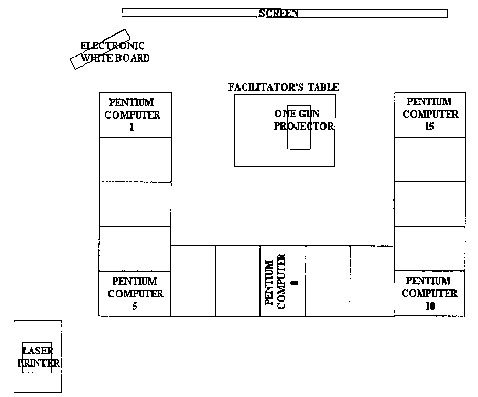
Figure 6. Groupware Laboratory Configuration.
The Groupware Laboratory computers were loaded with VENTANA's GroupSystems 4 and Lotus Notes software. These software packages are designed to facilitate group synergy in brain storrning sessions, issue voting, collaborative document editing, and communications.
This laboratory is used to teach Decision Support Systems classes. The students are able to simulate a business environment where they are able to brainstorm ideas, build consensus, and develop documentation in a group environment.
This laboratory has also been used by outside business that wants to use this technology to conduct their business meetings. We anticipate more of this happening in the future.
Computer Assisted Presentations
With all of the student laboratories (72 Pentium computers in 4 laboratories) equipped with Microsoft's Professional Office, students in Introduction to Computers classes (a required, university-wide, freshman core requirement) are taught how to develop and use a PowerPoint presentation. They are required to research a topic (most students now use the Internet for their research), develop a PowerPoint presentation and present it to the class. This experience is designed to enhance their writing and presentation skills for the rest of their academic career.
With most textbooks today, authors typically provide PowerPoint presentations to accompany the text. These presentations are used in the classroom to enhance class lectures. As a result, professors are finding the use of these materials as invaluable aids in their teaching experience.
As with the student, professors are finding that developing PowerPoint presentations are easy and enjoyable. By designing their own presentations, professors can customize them to match their teaching style. In addition, the instructor can make handouts for the student or put the presentations on-line so students can view them whenever they wish. The net result is that the student benefits from the professional looking presentations and also have the ability to review the presentations any time, day or night, they wish.
SUMMARY
With the aid of two NSF grants for seed money, this university was able to propel itself from two laboratories with 20-286 personal computers each on Novell networks into
The net result is that students are now put into simulated business environments to experience what happens in the "real" world. They are allowed to experiment and make mistakes without the fear of losing their job. These students will be better prepared to enter the business environment than others without these experiential experiences do.
REFERENCES
1 NSF grants, NCR-9355010 and DUE-9351774.
2 Brent D. Heslop and David F. Angell, Mastering Solaris 2, 1993,
SYBEX Inc.
3 Interactive Development Environments, Inc., Software through Pictures:
Structured Environment;
Getting started with StP/SE, Release 6, 1996.
4 VENTANA Corporation, GroupSystems@Work, bimonthly
newsletter.